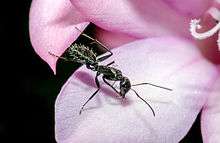Camponotus niveosetosus
Camponotus niveosetosus, commonly known as the hairy sugar ant, is one of the smaller species of sugar ant. It is native to an extensive region in the eastern Afrotropics.
| Hairy sugar ant | |
|---|---|
 | |
| Visiting a Watsonia flower | |
| Scientific classification | |
| Kingdom: | |
| Phylum: | |
| Class: | |
| Order: | |
| Family: | |
| Genus: | |
| Species: | C. niveosetosus |
| Binomial name | |
| Camponotus niveosetosus Mayr, 1862 | |
Description
They are dark grey to black in colour, with tellingly, copious stiff, almost snow-white hairs on the thorax and gaster.[1] The antennae and tarsi are ferruginous, and the mandibles dark castaneous red.[2] In addition to the thick and blunt white pilosity it is covered with a more yellowish, short and fine, decumbent pubescence.[2]
Range and habitat
They are found from Kenya to South Africa in a variety of habitats.[3][4] Only arid regions seem to be avoided. They are found in gardens, fynbos, grassland, savanna and various types of woodland, from the intertidal zone[5] at sea level to middle altitudes.[4]
Subspecies
Three subspecies are recognized:[4]
- Camponotus niveosetosus niveosetosus – continental Africa, type from South Africa
- Camponotus niveosetosus irredux Forel, 1910 – continental Africa, type from South Africa
- Camponotus niveosetosus madagascarensis Forel, 1886 – Madagascar
References
- Slingsby, Peter. "Camponotus species: Sugar ants". Ants of the Western Cape. Retrieved 7 October 2015.
- Arnold, G. (1922). "A monograph of the Formicidae of South Africa. Part V. Myrmicinae". Ann. S. Afr. Mus. 14: 579–674 (cf. p. 659).
- "Camponotus niveosetosus". AntWiki. Retrieved 8 October 2015.
- "Species: Camponotus niveosetosus Mayr, 1862". AntWeb v5.38.1. Retrieved 7 October 2015.
- Slingsby, Peter. "Ants in the littoral (observation)". ispot. Retrieved 8 October 2015.